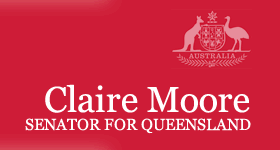Senator MOORE (Queensland) (21:59): Showing the shared commitment to Equal Pay Day, I also want to talk about the fact that Friday, 4 September was Equal Pay Day in our nation. Each year-and I have spoken many times on this issue-I remind people that we do not 'celebrate' Equal Pay Day, we acknowledge it. Equal Pay Day being on 4 September is a symbolic indication that 65 days is how many days a woman had to work this year to have equal pay with a man. As Senator Cash said in her contribution, there will perhaps be a time when we will be able to celebrate Equal Pay Day on 1 July, the same day for men and women-which, indeed, would be equal pay. Senator Cash talked about things that were being done in our country. I quote and requote Justice Mary Gaudron after the 1998 case. She said:
We got equal pay once-
that was the 1975 case-
then we got it again, and then we got it again, and now we still don't have it.
Those words that Justice Gaudron spoke in 1998 are just as real today. In terms of progress, I think there has been acknowledgement of the need and there has been ongoing effort. The work done by the Workplace Gender Equality Agency continues to remind us of exactly what is happening in our nation at the moment. They put out their statistical snapshot-and many of the stats that Senator Cash quoted are in there. But one thing I wanted to point to in particular is the issue about individual companies actually developing their own strategies to look at themselves, see what is happening in their own company and bring out a gender pay gap analysis. In last year's statistics from the Workplace Gender Equality Agency-and these are on the basis of reports they get from companies in our nation with over 100 employees-based on the reporting organisations that did conduct a gender pay gap analysis, last year nearly half of the companies, or about 46 per cent of the companies, went one step further and took action in their own company to address their gender pay gap. Of these, the majority said they reviewed the remuneration outcomes of individual employees, followed by identifying the causes of the gaps. They actually looked at what was happening in their workplace and saw why women were getting less money than men. It seems really straightforward. We have talked about it since the seventies but now, in 2015, some companies have actually taken action. They looked at the decision-making processes in the companies and designed an action plan to address the causes. Based on this action, they were able to see what was happening and what they could make happen into the future to make sure we get a little bit closer than the 65 extra days a woman has to work each year to have equal pay with men.
Tonight-and I will do this again in another contribution-I want to pay credit to the work of Liz Broderick, who has just retired as our Sex Discrimination Commissioner. Liz made her final public presentation at the Press Club last week and she raised a number of issues there about genuine equality in our nation. She said:
Gender equality is not a battle of sexes, it's a battle for equality, a battle that men and women must wage side by side. The empowerment of women is about the empowerment of humanity.
That is true. And tonight I want to talk about the actions that Liz has inspired around companies taking action themselves to look at the gender pay gap, the causes of inequality in their own companies. As we can see, the Workplace Gender Equality Agency has brought forward stats. But the male workplace organisation Champions of Change, which was inspired by Liz's work as Sex Discrimination Commissioner, has gone one step further. They have actually set up within their companies a commitment that there would be movements towards real equality. First of all, they had to identify that they were not there-and at the beginning of the process not all of these male champions, the leaders of large companies in Australia, truly acknowledged that there was a gap. They knew there were variations in payment and conditions but, until they actually talked with their employees and management teams to identify what was happening, they were largely unaware of the range of issues which impact on women in the workplace-and now they are putting into place real actions to make change. And that looks at hours of work, flexibility of work, work demands and the definition of 'merit' in the workplace-all those things we have talked about so often. But, really, the important aspect is that they have identified the need for change.
While people understand that there is a gap that costs women several hundred dollars each working week in terms of their take-home pay, these leaders have not said, 'It's too hard to do this, it takes too much time and there's too much red tape'-all those obstacles we hear about. Instead, they have actually shown true leadership. They have said, 'We can make a difference,' and they have worked with their workforce to ensure change occurs. That is something we are asking all employers to do. This is not somebody else's problem; this is a problem for all of us to identify in our community-that there is genuine inequality. As Justice Gaudron said, we keep on winning this equal pay acknowledgement but we just do not seem to be able to get it right. So there is a challenge in 2016. In 2015 the equal pay case has been acknowledged. In 2015 we saw the figures plummet from 18.1 per cent to 17.9 per cent. That is a cause for acknowledgement but not for celebration. For all the reasons that Senator Cash acknowledged, the challenge for us is to make a genuine commitment that we will do better-that we will not be asking what somebody else is doing about these issues, we will be implementing change in our own workplaces. That can take many different forms in the workplace, but what we must have is an acknowledgement that there will be change.
BPW Australia has acknowledged the process of Equal Pay Day for many years. They have actually said that collaboration between government and business employees is a long-term solution to closing the gap, but that women can take action now. An online pay and contract negotiation checklist, 'Know Your Value', can help secure better pay and conditions. We are encouraging women to seek out and to consider their own financial decisions, to maximise retirement incomes. We know that the long-term implications are very serious, with superannuation changes. We are going to have an inquiry in this place about women and super. This really reinforces the fact that this pay gap causes women to have significantly reduced superannuation earnings and security into the future. That means that the inequality continues.
BPW Australia says that we actually have online tools that help us to take control of our own salaries and wages. Too often there is a myth that women do not have the ability to negotiate effectively for their own pay and conditions. With support they can do so.
It is more than likely that in 12 months' time in this place many women and men will talk about Equal Pay Day 2016. I sincerely hope that it will be earlier in the year than 4 September. It would be very useful as we bring those days down closer to 1 July that we can see we are making progress. The partnerships that Senator Cash referred to in her contribution must be active, and we can do that. It is not just government that can make these changes. But government does have a role to play, and the work that is done by the Workplace Gender Equality Agency, which is actually funded by government, provides the tools to employers and employees to make change in their own workplaces. So in 2016 we may even knock that Equal Pay Day back right into the middle of August, and that would be some significant change to take into the future.




